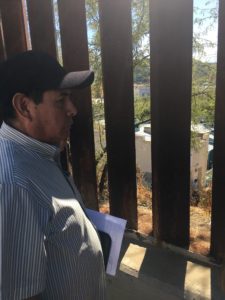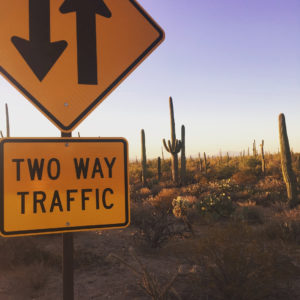Gina Collignon is UUCSJ’s Senior Associate for Immersion Learning. She recently led a group from the Bethesda, MD/Washington DC area (that included members from the Cedar Lane, All Souls Unitarian in DC, and Davies Memorial UU churches) to the Arizona/Mexico Border.

Manual at the Border Wall
“People used to visit here,” Manuel told us. “They would set up chairs and talk. Sometimes they would bring food and pass it through to each other.” We all stood on the U.S. side of the U.S./Mexico border. Rust iron slats rose high into the air, creating a physical barrier between us and the land that looked not that different mere feet away. Forces of the state had recently put up mesh wiring across the slats, effectively negating what little physical space remained open between the two neighboring lands. “Why would they do that?” Manuel continued. “Drugs didn’t come through there. They are too tiny of spaces. Families would come to be together, to spend time, to share things. Now, the fence blocks even that.”
The image stayed trapped in my head: family members bringing foldout chairs merely to be close to the physical presence of those they loved; friends coming to chat, state-sponsored separation notwithstanding. As we walked away, I fell into conversation with a fellow delegation member. “These borders are in our mind. It’s just a physical manifestation of our own fears.” She looked at me as if I had said the most obvious thing ever. “Yeah.”
Returning to Borderlinks with a church that had already decided to become a sanctuary church was an eye- and heart-opening experience. As we chatted (a group of adults already committed to justice and yet still learning what that means), someone realized that even though they had committed to being a sanctuary church, they lived in a city divided by race. A river acted as a border separating the two sides. This realization brought us to a deeper questioning of the word “sanctuary.” Is our church really a sanctuary? Who defines sanctuary? How do we know when we’ve achieved that status? As the week progressed, we practiced the act of meeting across borders through visiting with detainees, meeting with people at the forefront of working for immigration justice, through daring to sit with our own messy emotions and identities.
 As I watched Borderlinks magnificently guide us through our itinerary, again and again I thought, “These borders are in our mind.” And privilege means that our emotive borders become physical borders. Privilege means that unjust borders can be something that we’re blind to. Privilege means sometimes not seeing the socio-economic, race-based, gender-based, body-based, culture-based (and so many more) borders that surround us constantly. “People used to visit here,” Manuel had told us. “They would set up chairs and talk.” Maybe that is one of the first steps we have to do to deconstruct the internalized borders we all carry within us. Set up a chair and talk to the person across. This might be part of the movement that then carries us through the work of dismantling and opposing the physical and legal borders being legally enacted around us. Only when the borders come down can people truly meet.
As I watched Borderlinks magnificently guide us through our itinerary, again and again I thought, “These borders are in our mind.” And privilege means that our emotive borders become physical borders. Privilege means that unjust borders can be something that we’re blind to. Privilege means sometimes not seeing the socio-economic, race-based, gender-based, body-based, culture-based (and so many more) borders that surround us constantly. “People used to visit here,” Manuel had told us. “They would set up chairs and talk.” Maybe that is one of the first steps we have to do to deconstruct the internalized borders we all carry within us. Set up a chair and talk to the person across. This might be part of the movement that then carries us through the work of dismantling and opposing the physical and legal borders being legally enacted around us. Only when the borders come down can people truly meet.

